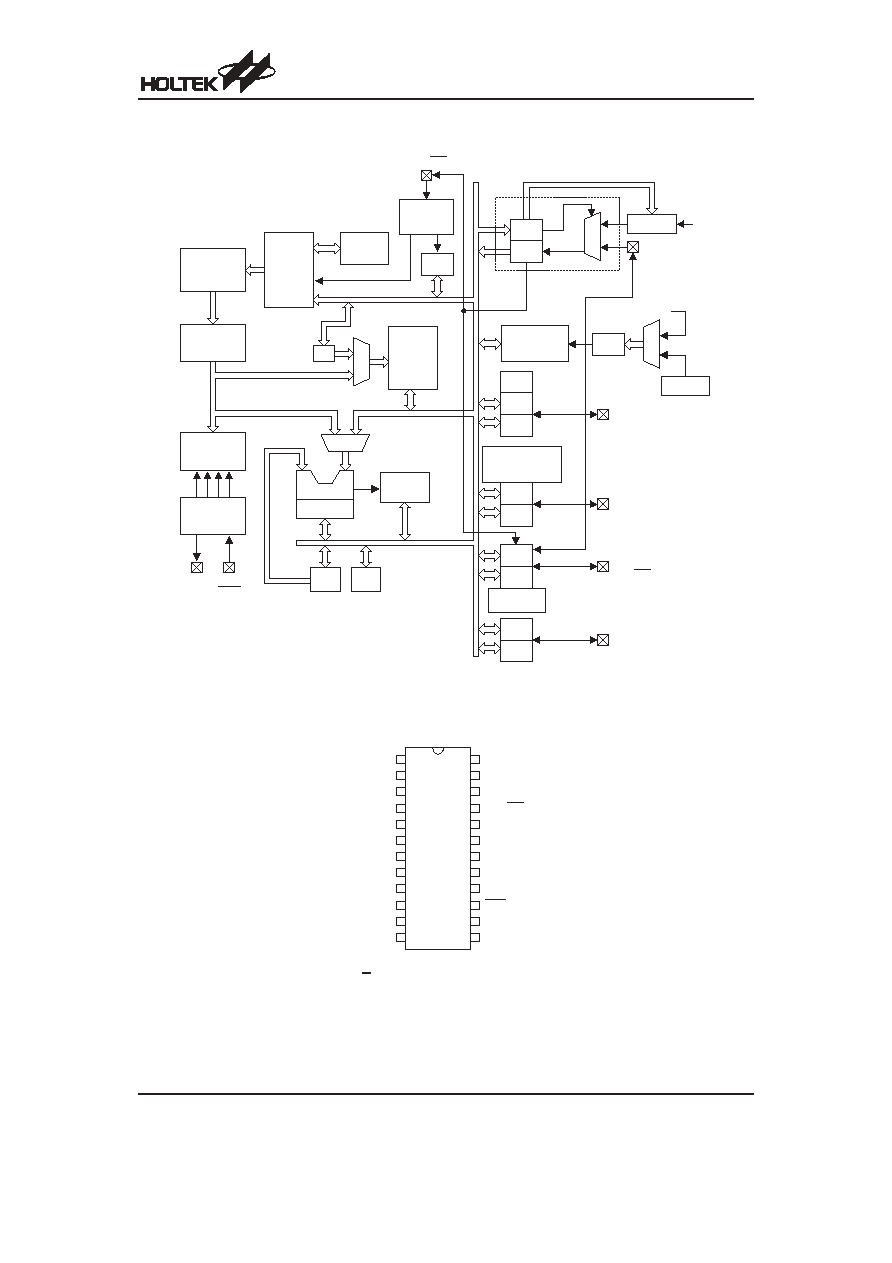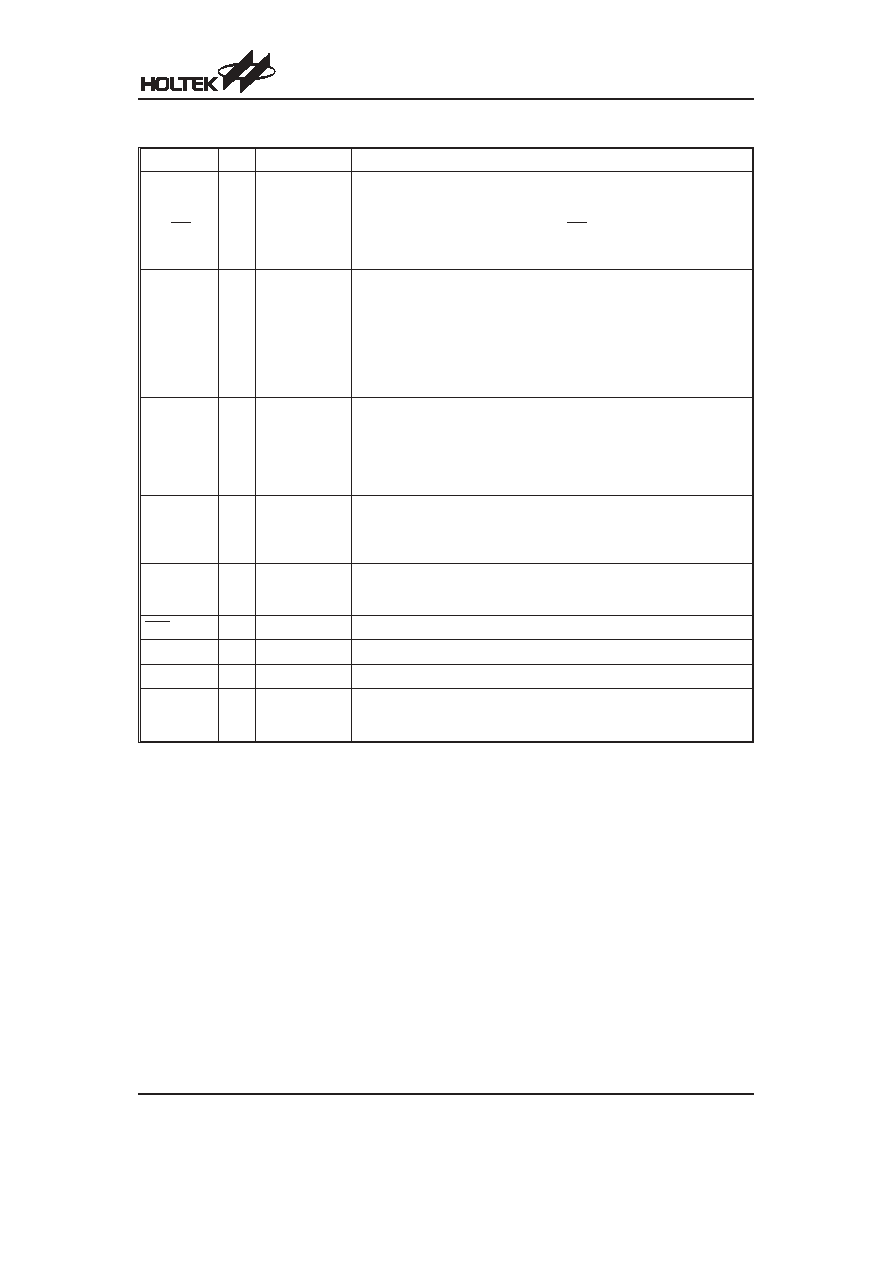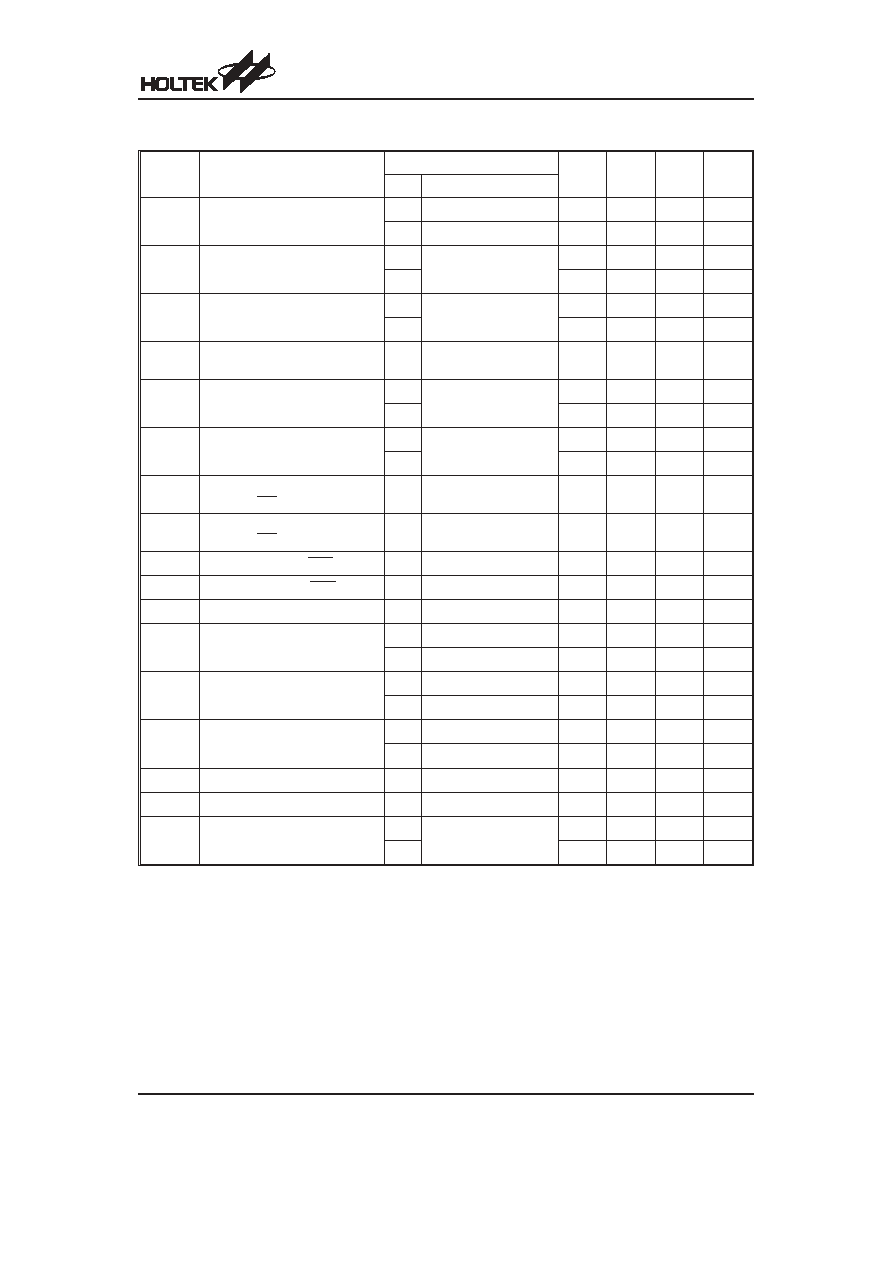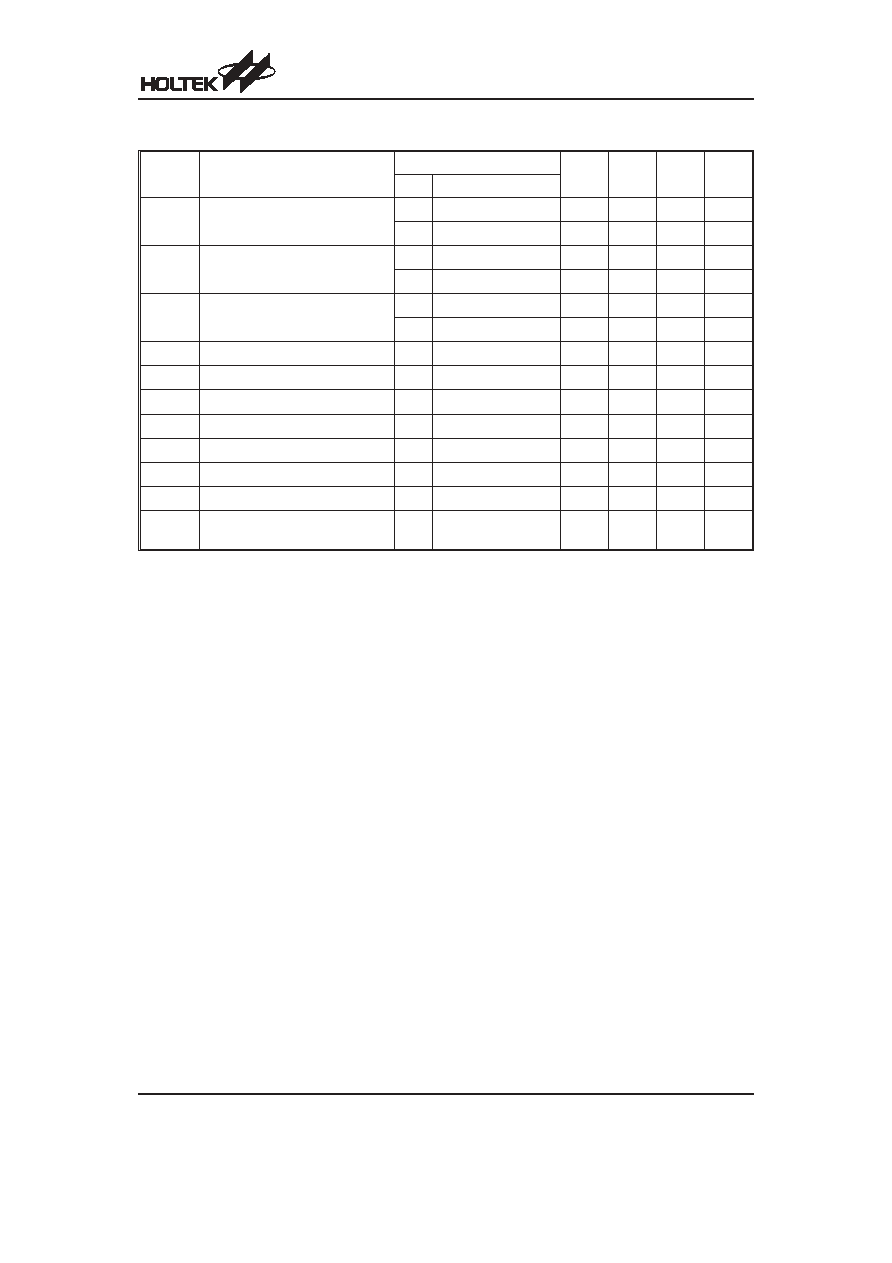 | ÐлекÑÑоннÑй компоненÑ: HT46RU22 | СкаÑаÑÑ:  PDF PDF  ZIP ZIP |
/home/web/doc/html/holtek/189445

HT46RU22
A/D Type 8-Bit MCU
I
2
C is a trademark of Philips Semiconductors
Rev. 1.00
1
July 13, 2006
General Description
The HT46RU22 are 8-bit, high performance, RISC ar-
chitecture microcontroller devices specifically designed
for A/D applications that interface directly to analog sig-
nals, such as those from sensors.
The advantages of low power consumption, I/O flexibil-
ity, programmable frequency divider, timer functions,
oscillator options, multi-channel A/D Converter, Pulse
Width Modulation function, UART function, I
2
C inter-
face, HALT and wake-up functions, enhance the versa-
tility of these devices to suit a wide range of A/D
application possibilities such as sensor signal process-
ing, motor driving, industrial control, consumer prod-
ucts, subsystem controllers, etc.
Features
·
Operating voltage:
f
SYS
=4MHz: 2.2V~5.5V
f
SYS
=8MHz: 3.3V~5.5V
·
19 bidirectional I/O lines (max.)
·
1 interrupt input shared with an I/O line
·
8-bit programmable timer/event counter with
overflow interrupt and 7-stage prescaler
·
On-chip crystal and RC oscillator
·
Watchdog Timer
·
2048
´14 program memory
·
64
´8 data memory RAM
·
Supports PFD for sound generation
·
HALT function and wake-up feature reduce power
consumption
·
Up to 0.5
ms instruction cycle with 8MHz system clock
at V
DD
=5V
·
6-level subroutine nesting
·
8 channels 9-bit resolution A/D converter
·
1-channel 8-bit PWM output shared with one I/O line
·
Universal Asynchronous Receiver Transmitter
(UART)
·
Bit manipulation instruction
·
14-bit table read instruction
·
63 powerful instructions
·
All instructions in one or two machine cycles
·
Low voltage reset function
·
I
2
C Bus (slave mode)
·
24-pin SKDIP/SOP/SSOP package
Technical Document
·
Tools Information
·
FAQs
·
Application Note
-
HA0004E HT48 & HT46 MCU UART Software Implementation Method
-
HA0005E Controlling the I2C bus with the HT48 & HT46 MCU Series
-
HA0013E HT48 & HT46 LCM Interface Design
-
HA0047E An PWM application example using the HT46 series of MCUs

Block Diagram
Pin Assignment
HT46RU22
Rev. 1.00
2
July 13, 2006
P A 5 / I N T
O S C 2
O S C 1
R E S
V D D
M U X
P A C
P A
P o r t A
P A 4 / T M R
P o r t D
P o r t B
T M R
T M R C
V S S
P r e s c a l e r
f
S Y S
P A 4
P r o g r a m
R O M
P r o g r a m
C o u n t e r
I n t e r r u p t
C i r c u i t
S T A C K
I N T C
D A T A
M e m o r y
I n s t r u c t i o n
R e g i s t e r
M
U
X
I n s t r u c t i o n
D e c o d e r
S T A T U S
A L U
S h i f t e r
T i m i n g
G e n e r a t o r
R C O S C
W D T
P r e s c a l e r
M
U
X
M
U
X
M P
P A 3 / P F D
P A 3 , P A 5
P C
P C C
P C 0 / T X , P C 1 / R X
I
2
C B u s
S l a v e M o d e
P o r t C
f
S Y S
/ 4
A C C
L V R
P B
P B C
P A 0 ~ P A 2
P A 3 / P F D
P A 4 / T M R
P A 5 / I N T
P A 6 / S D A
P A 7 / S C L
P B 0 / A N 0 ~
P B 7 / A N 7
P D
P D C
P W M
W D T
P D 0 / P W M
8 - C h a n n e l
A / D C o n v e r t e r
H T 4 6 R U 2 2
2 4 S K D I P - A / S O P - A / S S O P - A
P B 5 / A N 5
P B 4 / A N 4
P A 3 / P F D
P A 2
P A 1
P A 0
P B 3 / A N 3
P B 2 / A N 2
P B 1 / A N 1
P B 0 / A N 0
V S S
P C 0 / T X
P B 6 / A N 6
P B 7 / A N 7
P A 4 / T M R
P A 5 / I N T
P A 6 / S D A
P A 7 / S C L
O S C 2
O S C 1
V D D
R E S
P D 0 / P W M
P C 1 / R X
2 4
2 3
2 2
2 1
2 0
1 9
1 8
1 7
1 6
1 5
1 4
1 3
1
2
3
4
5
6
7
8
9
1 0
1 1
1 2

Pad Description
Pad Name
I/O
Options
Description
PA0~PA2
PA3/PFD
PA4/TMR
PA5/INT
PA6/SDA
PA7/SCL
I/O
Pull-high
Wake-up
PA3 or PFD
I/O or Serial Bus
Bidirectional 8-bit input/output port. Each bit can be configured as wake-up
input by options. Software instructions determine the CMOS output or
Schmitt trigger input with or without pull-high resistor (determined by pull-high
options: bit option). The PFD, TMR and INT are pin-shared with PA3, PA4
and PA5, respectively. Once the I
2
C Bus function is used, the internal regis-
ters related to PA6 and PA7 can not be used.
PB0/AN0
PB1/AN1
PB2/AN2
PB3/AN3
PB4/AN4
PB5/AN5
PB6/AN6
PB7/AN7
I/O
Pull-high
Bidirectional 8-bit input/output port. Software instructions determine the
CMOS output, Schmitt trigger input with or without pull-high resistor (deter-
mined by pull-high option: port option) or A/D input.
Once a PB line is selected as an A/D input (by using software control), the
I/O function and pull-high resistor are disabled automatically.
PC0/TX
PC1/RX
I/O
Pull-high
Bidirectional 2-bit input/output port. Software instructions determine the
CMOS output, Schmitt trigger input with or without pull-high resistor (deter-
mine by pull-high option: bit option).
TX and RX are pin-shared with PC0 and PC1, once the UART Bus function
is used, the internal registers related to PC0 and PC1 can not be used. Soft-
ware instructions determine the UART function to be used.
PD0/PWM
I/O
Pull-high
I/O or PWM
Bidirectional 1-bit input/output port. Software instructions determine the
CMOS output, Schmitt trigger input with or without a pull-high resistor (de-
termined by pull-high option: port option). The PWM output function is
pin-shared with PD0 (dependent on PWM options).
OSC1
OSC2
I
O
Crystal or RC
OSC1, OSC2 are connected to an RC network or a Crystal (determined by
options) for the internal system clock. In the case of RC operation, OSC2 is
the output terminal for 1/4 system clock.
RES
I
¾
Schmitt trigger reset input. Active low.
VSS
¾
¾
Negative power supply, ground.
VDD
¾
¾
Positive power supply
TEST1
TEST2
TEST3
I
¾
TEST mode input pin
It disconnects in normal operation
Absolute Maximum Ratings
Supply Voltage ...........................V
SS
-0.3V to V
SS
+6.0V
Storage Temperature ............................
-50°C to 125°C
Input Voltage..............................V
SS
-0.3V to V
DD
+0.3V
Operating Temperature...........................
-40°C to 85°C
Note: These are stress ratings only. Stresses exceeding the range specified under
²Absolute Maximum Ratings² may
cause substantial damage to the device. Functional operation of this device at other conditions beyond those
listed in the specification is not implied and prolonged exposure to extreme conditions may affect device reliabil-
ity.
HT46RU22
Rev. 1.00
3
July 13, 2006

D.C. Characteristics
Ta=25
°C
Symbol
Parameter
Test Conditions
Min.
Typ.
Max.
Unit
V
DD
Conditions
V
DD
Operating Voltage
¾
f
SYS
=4MHz
2.2
¾
5.5
V
¾
f
SYS
=8MHz
3.3
¾
5.5
V
I
DD1
Operating Current
(Crystal OSC)
3V
No load, f
SYS
=4MHz
ADC disable
¾
0.6
1.5
mA
5V
¾
2
4
mA
I
DD2
Operating Current
(RC OSC)
3V
No load, f
SYS
=4MHz
ADC disable
¾
0.8
1.5
mA
5V
¾
2.5
4
mA
I
DD3
Operating Current
(Crystal OSC, RC OSC)
5V
No load, f
SYS
=8MHz
ADC disable
¾
4
8
mA
I
STB1
Standby Current
(WDT Enabled)
3V
No load, system HALT
¾
¾
5
mA
5V
¾
¾
10
mA
I
STB2
Standby Current
(WDT Disabled)
3V
No load, system HALT
¾
¾
1
mA
5V
¾
¾
2
mA
V
IL1
Input Low Voltage for I/O Ports,
TMR and INT
¾
¾
0
¾
0.3V
DD
V
V
IH1
Input High Voltage for I/O Ports,
TMR and INT
¾
¾
0.7V
DD
¾
V
DD
V
V
IL2
Input Low Voltage (RES)
¾
¾
0
¾
0.4V
DD
V
V
IH2
Input High Voltage (RES)
¾
¾
0.9V
DD
¾
V
DD
V
V
LVR
Low Voltage Reset
¾
¾
2.7
3
3.3
V
I
OL
I/O Port Sink Current
3V
V
OL
=0.1V
DD
4
8
¾
mA
5V
V
OL
=0.1V
DD
10
20
¾
mA
I
OH
I/O Port Source Current
3V
V
OH
=0.9V
DD
-2
-4
¾
mA
5V
V
OH
=0.9V
DD
-5
-10
¾
mA
R
PH
Pull-high Resistance
3V
¾
20
60
100
k
W
5V
¾
10
30
50
k
W
V
AD
A/D Input Voltage
¾
¾
0
¾
V
DD
V
E
AD
A/D Conversion Error
¾
¾
¾
±0.5
±1
LSB
I
ADC
Additional Power Consumption
if A/D Converter is Used
3V
¾
¾
0.5
1
mA
5V
¾
1.5
3
mA
HT46RU22
Rev. 1.00
4
July 13, 2006

A.C. Characteristics
Ta=25
°C
Symbol
Parameter
Test Conditions
Min.
Typ.
Max.
Unit
V
DD
Conditions
f
SYS
System Clock
(Crystal OSC, RC OSC)
¾
2.2V~5.5V
400
¾
4000
kHz
¾
3.3V~5.5V
400
¾
8000
kHz
f
TIMER
Timer I/P Frequency
(TMR)
¾
2.2V~5.5V
0
¾
4000
kHz
¾
3.3V~5.5V
0
¾
8000
kHz
t
WDTOSC
Watchdog Oscillator Period
3V
¾
45
90
180
ms
5V
¾
32
65
130
ms
t
RES
External Reset Low Pulse Width
¾
¾
1
¾
¾
ms
t
SST
System Start-up Timer Period
¾
Wake-up from HALT
¾
1024
¾
*t
SYS
t
LVR
Low Voltage Width to Reset
¾
¾
0.25
1
2
ms
t
INT
Interrupt Pulse Width
¾
¾
1
¾
¾
ms
t
AD
A/D Clock Period
¾
¾
1
¾
¾
ms
t
ADC
A/D Conversion Time
¾
¾
¾
76
¾
t
AD
t
ADCS
A/D Sampling Time
¾
¾
¾
32
¾
t
AD
t
IIC
I
2
C Bus Clock Period
¾
Connect to external
pull-high resistor 2k
W
64
¾
¾
*t
SYS
Note: *t
SYS
=1/f
SYS
HT46RU22
Rev. 1.00
5
July 13, 2006
Document Outline
- þÿ
- þÿ
- þÿ
- þÿ
- þÿ
- þÿ
- þÿ
- þÿ
- þÿ
- þÿ
- þÿ
- þÿ
- þÿ
- þÿ
- þÿ




